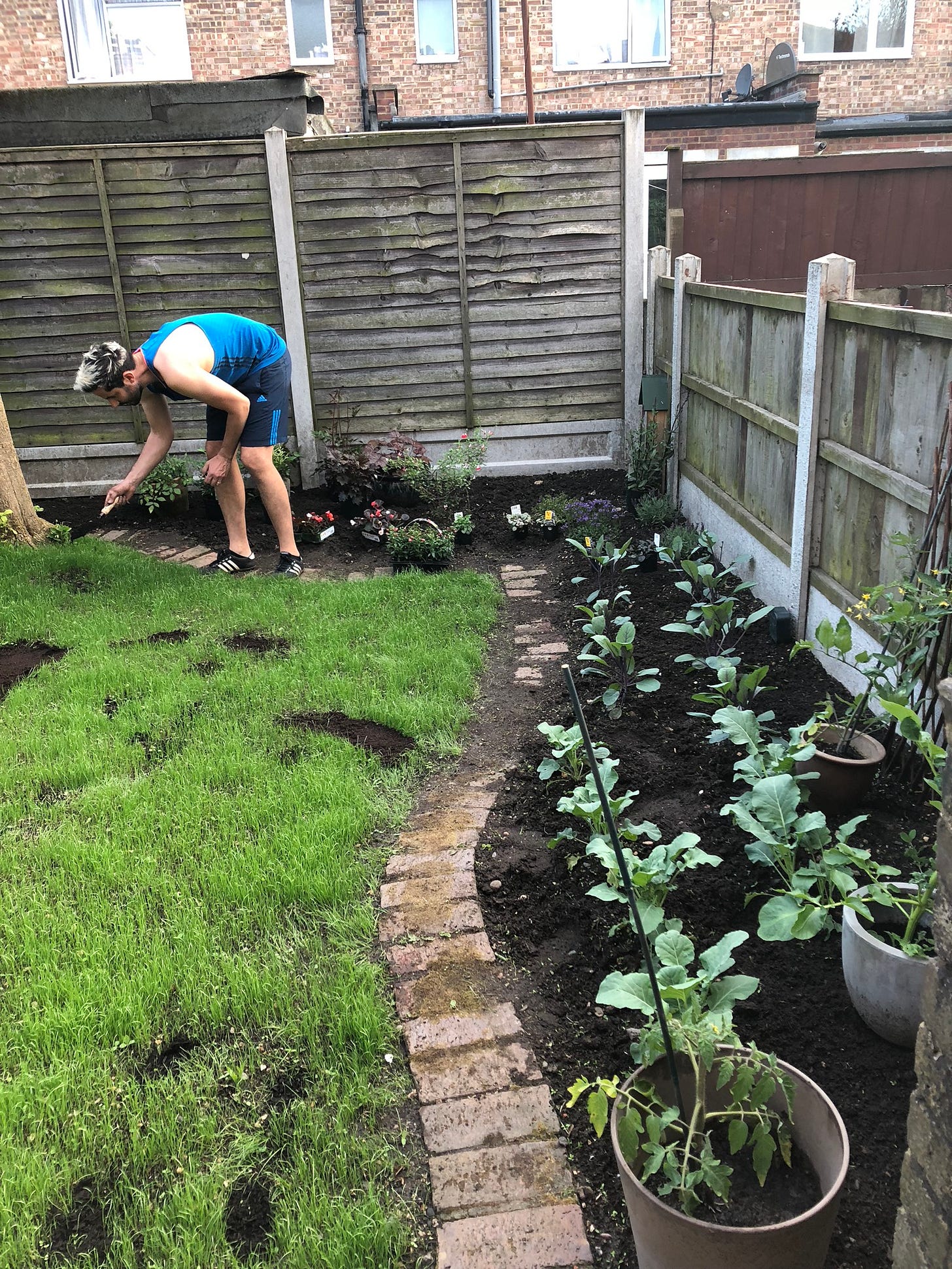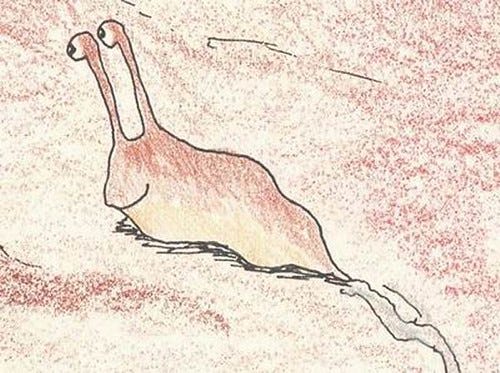When is a pest not a pest?
Slugs, snails, caterpillars & co have got a nasty rep – but is it deserved, or just bad PR?
You’re reading The Earthworm, a brand new newsletter that takes a sideways look at the world of gardens, gardening, horticulture and all that good green stuff. If this is your first time here, you can catch up on anything you’ve missed by following this link. Subscribe now for free and join the community!
Everyone remembers their first time. For some people it just… happens, taking them completely by surprise. Others may have waited for it, planned for it, discussed it with friends, watched videos online, purchased protection, all in anxious anticipation of when their rite of passage would come. But when it does come, no-one can prepare you for how awful it is.
My first time was worse than I could ever have imagined. Thinking about it today still makes my skin crawl, and I feel such deep shame bringing it up with more experienced friends that I tend to avoid talking about it at all. Deep breath. Confession time.
It was the summer of 2018. I was 32 at the time, which is late, I know, by many people’s standards. My girlfriend and I had spent a long weekend up in the Lake District, for a friend’s wedding. We got home late, after a long journey by road and rail, but I couldn’t wait. I was fizzing with excitement. I took my then-girlfriend-now-wife (let’s just call her “Ruth”, because that’s her name) by the hand, and together we stepped out into the garden.
It was our first summer of taking any real interest in the garden, and armed with precisely zero knowledge of anything horticultural, we’d decided to give almost all of our growing space over to veg. The right-hand border, the sunniest spot in the garden, was home to six red cabbages and six broccolis, each of which we had watched grow from two-inch-high plugs into unfeasibly enormous mature plants, barely contained within the confines of the border.
Yes, we had used our premium sun-soaked growing space to produce a sum total of 12 vegetables, all of which would reach maturity painfully slowly and would have to be harvested at basically the same time. But we didn’t care. We were young and naive and full of rookie enthusiasm. Until that night.
It was a muggy August evening, stiflingly close. And dark. We had no external light at the time; clouds obscured the moon. Ruth took out her phone and turned on the torch. Something wasn’t right with my eyes. I squeezed them shut, then slowly opened them again. Still not right. I squinted, and stepped up from the patio onto the lawn. What was going on with my vision? I was looking down at the brassicas, but I couldn’t focus. It was as if the entire bed was… swimming. I approached the plants, kneeled down and reached my hand out to touch one of the broad cabbage leaves, then practically fell over backwards in disgust.
Forget “pests”, this was a plague. I felt sick. I’d never seen anything like it. Caterpillars. Hungry hungry caterpillars. Literally thousands of them. All 12 plants – an entire summer’s worth of gardening and growing – were now covered with wriggling, writhing creatures, clambering over each other to gorge themselves on whatever skeletal scraps were still clinging onto the plants’ central stalks. Ruth and I backed away in horror and went back inside. Like I say, the thought of it still makes my skin crawl; still brings me shame.
Pests take many guises. Some, like caterpillars, slugs and snails, kill your plants by munching their leaves. Others, like birds and squirrels, plunder the literal fruits of your labour. And then there are the diggers: foxes, cats, moles, all of whom are entirely disinterested in your plants, but will obliviously destroy them anyway through their brutish soil-scraping antics.
We hate pests, because they threaten our best-laid plans. We put days, weeks, months and years’ worth of time, energy, care and labour into our growing spaces, so when some external force – like a hungry mouse, or a miss-kicked football – undoes it all, we are understandably enraged. And in many cases, these pests bring out our cruellest instincts.
Traps, poisons, stomping boots and salt-filled sandwich bags, all inconceivably cruel, suddenly seem not just justifiable but necessary when our precious dahlia’s late summer display comes under threat. The shelves of B&Q are lined with potent chemicals. Gardening magazines and online message boards overflow with ever-weirder gadgets and gimmicks and DIY pest control solutions.

Like meteorologists measuring extreme weather events, you’ll hear veteran gardeners talk about plagues past, tracking the passing of time by whatever scourge happened to lay their prized veg to waste that year. “I haven’t seen this much greenfly since 2015! Remember your runner beans that summer, Geoff? What a disaster.”
Pests play such a major part in the consciousness of gardeners that for 25 years, the RHS published an annual list of the nation’s most loathed garden invaders. But no longer. Last week, instead of releasing the 26th edition of the garden pest chart, the RHS announced not just that it was scrapping it, but that it was scrapping the term pest altogether.
The charity’s principle entomologist, Andrew Salisbury, said in a statement: “The RHS is all too aware of the role that gardens have in supporting biodiversity and as such will no longer label any garden wildlife as ‘pests’. Instead, there will be greater consideration of and focus on the role that slugs, aphids and caterpillars play in a balanced garden ecosystem along with more popular wildlife (or animals) such as birds, hedgehogs and frogs.”
It seems that the RHS has had a change of heart. And actually, so have I.
For the longest time, we have thought of our gardens as, well, ours. We put up walls and fences, marking our territory and sending a pretty clear message: keep out. It is we who decide what grows where, and for what purpose. We feed, we weed, we sow our seed. We therefore take issue with any creature – great or small – who interferes with these schemes.
And yet, at the same time, the more enlightened gardeners among us (he says smugly) are going out of our way to invite wildlife into our gardens. We introduce pollinator-friendly plants; we create hedgehog corridors; we buy bird feeders and bug hotels; some of us create ponds. We like to think of ourselves as benign conservators of the natural world, though of course what we’re really saying is: Some wildlife is welcome, as long as it’s cute, cuddly or useful.
Ding-ding-ding! Cognitive dissonance alert! After all, when we plant a hosta in a dark, damp corner, or direct-sow our sweet peas, aren’t we actually sending out a pretty clear signal to slugs and snails? “Dinner is served!” Those molluscs, caterpillars, weevils and the rest aren’t there to spite us; they’re there because we have created an environment that offers them free food and shelter. What could have been more inviting to my biblical plague of cabbage white caterpillars, the memory of which makes me shudder to this day, than an entire border’s worth of un-netted brassicas?
If you really hate slugs, aphids, caterpillars, foxes, rabbits, mice and moles that much, there’s one sure-fire way to keep them out of your garden: don’t grow any plants. (I hope, if you’re reading this, that you’ll agree that that isn’t actually an option.)
What this ultimately comes back to, as anyone who read my recent post on Attenborough’s latest series The Green Planet will recognise, is language. When we label something a “pest”, we immediately establish an adversarial relationship with it, an Us vs Them. And, being humans, when presented with an adversary we get very aggressive very quickly. How dare a soil-dwelling mollusc dwell in my soil? How dare a root-nibbling insect nibble my roots? How dare a berry-gobbling mammal gobble my berries?
But “pests” are as integral a part of the complex web of life in our outdoor spaces as any blue tit or bumblebee. And if we accept that there’s no such thing as a pest, per se – a creature hellbent on making life difficult for us – then maybe we will be more inclined to live and let live. Hey, slugs will be slugs! (And actually, many species of slugs play an important role not just as food for more photogenic garden visitors, but also in recycling animal waste and dead plant material – useful!)
None of which is to say that gardeners will – or even should – give up trying to keep slugs et al from munching their seedlings. What world-renowned and prestigious institutions like the RHS and The Earthworm are suggesting is simply to adopt a more holistic approach. Basically, the advice, as ever, is to work with nature, not against it.
But how? Well, you know what’s even more effective than going out at night with a head torch and a bagful of salt and a blood-curdling appetite for melting molluscs? Frogs. If you have frogs, or toads, or hedgehogs living near your hostas – which I gather you will, if you have a pond – then the slugs are goners. If you keep the chemicals in the cupboard, and instead plant yarrows and pot marigolds, the ladybird larvae you’ve just provided a home for will feast on those pesky sap-sucking aphids all summer long. Wasps harshing your mellow? Chill out: they’ll soon be decapitating the cabbage white caterpillars on your veg patch.1
It’s embarrassing really, but we humans are always so desperate to find inventive new ways of tackling our problems, that we usually neglect the tried-and-tested old ways for doing the very same.
None of which is to say that the next time I find glossy slime trails, glinting like morning dew on what remains of my seedlings, I won’t be sent into a murderous rage. Or that when I next trip over a freshly excavated crater in the lawn, I won’t want to throttle the little fox cub responsible. But I will at least acknowledge that while nature can be a nuisance, the world – and my garden – would be a much poorer place without it.
Have you had any issues with unwanted garden visitors? Will you stop using the word pest? Has the RHS lost its collective mind? Or is it high time we welcomed all forms of wildlife into our back yards, however slimy and/or voracious?
Header image picture credit: "happy slug" by hurleygurley is marked with CC BY-NC-ND 2.0.
Before you go, exciting news for iPhone users: You can now read The Earthworm in the new Substack app for iOS.
With the app, you’ll have a dedicated Inbox for my Substack and any others you subscribe to. New posts will never get lost in your email filters, or stuck in spam. Longer posts will never be cut-off by your email app. Comments and rich media (like video and audio) will all work seamlessly. Overall, it’s a big upgrade to the reading experience.
The Substack app is currently available for iOS. If you don’t have an Apple device, you can join the Android waitlist here.
Wasps literally decapitate caterpillars, then carry their lifeless bodies back to their nests to feed to their young. Wasps are amazing garden predators and won’t sting unless provoked, so no need to shoo them away.






loved the article and was almost convinced by the arguments but...I still do not like creepy crawlies
I do my best to attract a wide variety of critters to our yard but I definitely see and feel both sides of this issue. I do love watching baby rabbits visit our yard in the spring but I also still send out the dog when they start nibbling on the sweet peas.